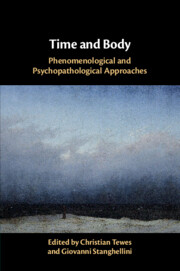Book contents
- Time and Body
- Endorsements for Time and Body
- Time and Body
- Copyright page
- Dedication
- Additional material
- Contents
- Figures
- Contributors
- 1 Introduction – Time and Body
- 2 Time, the Body, and the Other in Phenomenology and Psychopathology
- Part I Body and Time: General Aspects
- Part II Grief and Anxiety
- Part III Borderline Personality and Eating Disorders
- 9 Emotion Regulation in a Disordered World
- 9.1 Commentary on “Emotion Regulation in a Disordered World: Understanding Borderline Personality Disorder”
- 10 Nobody? Disturbed Self-Experience in Borderline Personality Disorder and Four Kinds of Instabilities
- 10.1 Commentary on “Nobody? Disturbed Self-Experience in Borderline Personality Disorder and Four Kinds of Instabilities”
- 11 Levels of Embodiment
- 11.1 Commentary on “Levels of Embodiment: A Husserlian Analysis of Gender and the Development of Eating Disorders”
- 12 Phenomenology of Corporeality (and Spatiality) in Anorexia Nervosa with a Reference to the Problem of Its Temporality
- 12.1 Commentary on “Phenomenology of Corporeality (and Spatiality) in Anorexia Nervosa with a Reference to the Problem of Its Temporality”
- Part IV Depression, Schizophrenia, and Dementia
- Index
- References
9 - Emotion Regulation in a Disordered World
Understanding Borderline Personality Disorder
from Part III - Borderline Personality and Eating Disorders
Published online by Cambridge University Press: 30 October 2020
- Time and Body
- Endorsements for Time and Body
- Time and Body
- Copyright page
- Dedication
- Additional material
- Contents
- Figures
- Contributors
- 1 Introduction – Time and Body
- 2 Time, the Body, and the Other in Phenomenology and Psychopathology
- Part I Body and Time: General Aspects
- Part II Grief and Anxiety
- Part III Borderline Personality and Eating Disorders
- 9 Emotion Regulation in a Disordered World
- 9.1 Commentary on “Emotion Regulation in a Disordered World: Understanding Borderline Personality Disorder”
- 10 Nobody? Disturbed Self-Experience in Borderline Personality Disorder and Four Kinds of Instabilities
- 10.1 Commentary on “Nobody? Disturbed Self-Experience in Borderline Personality Disorder and Four Kinds of Instabilities”
- 11 Levels of Embodiment
- 11.1 Commentary on “Levels of Embodiment: A Husserlian Analysis of Gender and the Development of Eating Disorders”
- 12 Phenomenology of Corporeality (and Spatiality) in Anorexia Nervosa with a Reference to the Problem of Its Temporality
- 12.1 Commentary on “Phenomenology of Corporeality (and Spatiality) in Anorexia Nervosa with a Reference to the Problem of Its Temporality”
- Part IV Depression, Schizophrenia, and Dementia
- Index
- References
Summary
This paper addresses the phenomenology of emotion dysregulation, focusing on borderline personality disorder (BPD). We emphasize how (a) emotions ordinarily arise within the context of a structured experiential world, (b) emotions play a role in maintaining, repairing, and reshaping that world, and (c) both the world's stability and the workings of emotion processes depend on our being able to relate to other people in certain ways. We go on to show how, if (a), (b), and (c) are accepted, emotion dysregulation (of the kind associated with BPD) is implied by a way of experiencing and relating to the social world as whole. Hence, it is not to be conceived of simply as a matter of disordered emotion. Rather, it involves emotions operating upon a disordered world. Furthermore, given that other people play essential roles in sustaining a structured, practically meaningful world and regulating the emotions that arise within it, emotion regulation and dysregulation turn out to be interpersonal, rather than wholly intrapersonal, in structure.
Keywords
- Type
- Chapter
- Information
- Time and BodyPhenomenological and Psychopathological Approaches, pp. 177 - 200Publisher: Cambridge University PressPrint publication year: 2020



